The AMD Llano Notebook Review: Competing in the Mobile Market
by Jarred Walton & Anand Lal Shimpi on June 14, 2011 12:01 AM ESTPower Gating
With 1.45 billion transistors on die, Llano relies on extensive power gating in order to keep things in order. The APU is split into two independent power islands: the CPU and the GPU. The memory controller and North Bridge both live on the GPU's power island. Each island has its own independent voltage source.
Everything from an individual CPU core to the entire GPU or virtually the entire APU package can be power gated. AMD provided photon recombination images to show the impact power gating the GPU can have on leakage current:
Although not depicted above, Llano can also fully power gate the x86 CPU cores or both the CPU and GPU if the entire APU is in a deep sleep state. Being able to completely power gate CPU cores or the GPU is an important part of enabling the next major feature of Llano: Turbo Core.
Turbo Core
All processors whether CPUs, GPUs or APUs have to be designed to strict thermal and power limits. OEMs need to know exactly what sort of chassis they'll be able to build around these chips and as a result the chip vendors provide guidance in the form of specifications, including the chip's thermal design point (TDP).
In the old days of microprocessors things were simple. You had a single core that ran all the time and it consumed all of the available thermal budget allocated for that core. AMD and Intel eventually enabled dynamic clock frequencies which let your single core underclock itself when it wasn't being used, which helped reduce power and extend battery life. Then came the multi-core era.
CPUs couldn't just start putting out twice as much heat now that they had two cores; instead, each core had to consume less power. The chip guys achieved this by running the cores at lower frequencies and voltages than they did in the single-core days. Two cores paved the way to four cores, which meant another reduction in clock speed per core. Sure we got much better multi-threaded performance, but for single-threaded applications performance wasn't as great as it could be. Users had to make a tradeoff: good multi-threaded performance or good single-threaded performance; you couldn't have both. Until power gating came along that is.
Without power gating you can never really shut off power to an idle core. The transistors aren't switching but power is still dissipated thanks to leakage current. Remember that transistors don't simply stop conducting electricity when they're off. The smaller they get, the more leaky our beloved transistors become. Power gating lets you physically block the flow of current to the transistors that are being gated, so when they're off, they're actually off. With an idle core shut off, now you have the extra TDP headroom to run any active cores at higher frequencies.
Intel does this with a technology it calls Turbo Boost. Intel looks at current draw and thermal sensors spread out all over the chip and determines when it has the available thermal headroom to turbo up any active cores. AMD implements a similar technology in Llano (and previously in their hex-core desktop parts) called Turbo Core.
I say similar but not identical because AMD's approach differs in a very important way. While Intel looks at current draw and temperature data, AMD looks at workload. Each activity within the Llano APU is assigned a certain power weight (e.g. an integer multiply is known to require a certain amount of power). Llano is aware of the operations it's currently working on and based on the weights associated with these operations it comes up with a general estimate of its power consumption on a per core basis. I mention this is an estimate because it correlates digital activity to power consumption; it doesn't actually measure power consumption.
Based on the number of events and their individual weights, AMD estimates the power consumption of each core and determines how much TDP headroom exists in the system. If the OS is requesting the highest p-state from the CPU and there's available TDP headroom, Llano will turbo up any active cores up to a maximum frequency. Like Sandy Bridge, Llano is able to temporarily exceed the APU's maximum TDP if it determines that the recent history of power consumption has been low enough that it'll take a while for the APU to ramp up to any thermal limits.
One major limit of Llano's Turbo Core is that the GPU can't turbo up in the event of the CPU cores being idle. Only the CPU cores can turbo up if they have available headroom. I suspect future versions of Llano will probably enable GPU Turbo Core as well:
It's unclear to me at this point what shortcomings or advantages exist for AMD's Turbo Core method vs. Intel's Turbo Boost. At the bare minimum the two are finally comparable although they use different approaches to attain a similar end result. AMD doesn't yet have a method of actually displaying Turbo Core frequencies, unfortunately, so we're operating a bit blind at this point. Over time I hope to have a better idea of how AMD's solution stacks up.


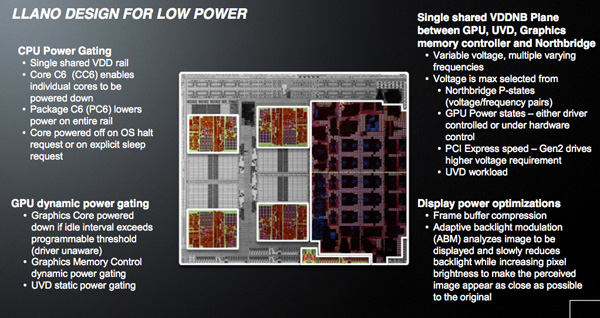
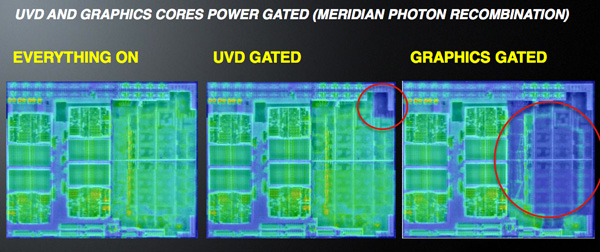
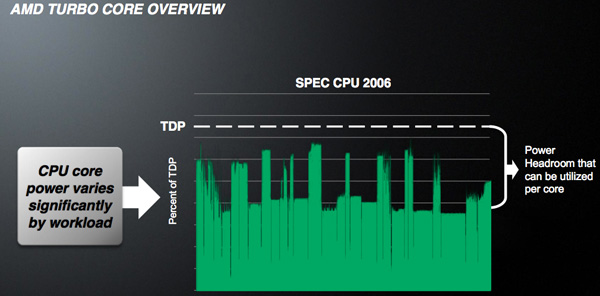
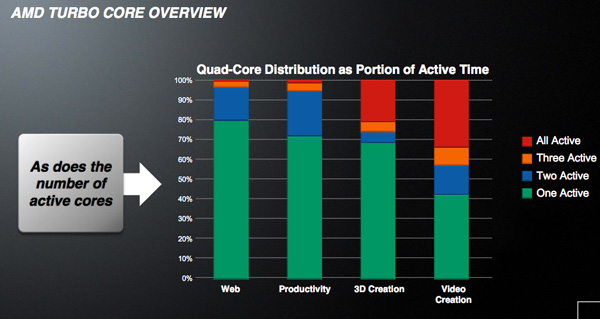
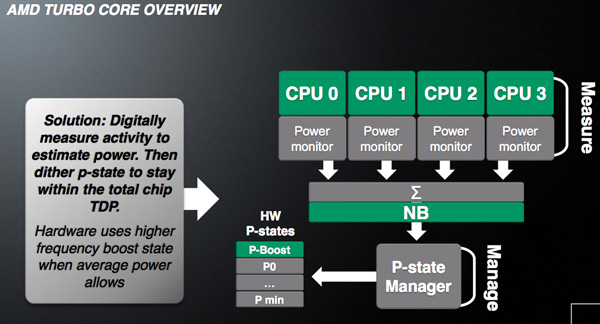
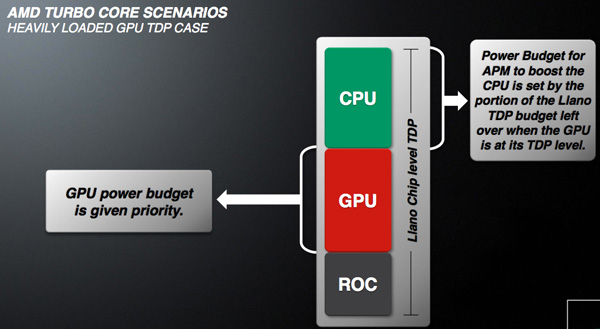
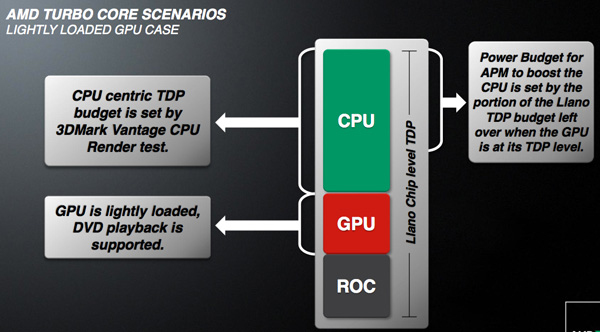








177 Comments
View All Comments
sinigami - Tuesday, June 14, 2011 - link
these prices, are definitively NOT in the netbook range:$500 - thinkpad x120e
$550 - HP Pavilion dm1
$600 - sony vaio YB
who the hell would pay that much dough for Atom level performance?
sinigami - Tuesday, June 14, 2011 - link
even AMD's slower 1.0GHz C-50, costs more than the Atom in the SAME MODEL netbook (while benchmarking slower than the atom!):$250 - Acer Aspire One 255 with the FASTER Intel Atom
$330 - Acer Aspire One 522 with the SLOWER AMD C-50
ET - Wednesday, June 15, 2011 - link
First of all, the (lowest) prices I found at Amazon.com were $250 for the 255 and $310 for the 522, which is a smaller margin.Acer 522 has a 720p display vs. the 255's 1024x600. That alone is worth a significant price difference. It also has a HDMI port and a CPU (APU) that can play 1080p HD videos (or 720p on the internal display). The 255 is worth crap for video playback, a very common laptop use these days.
The C-50 can also play some games. Sure, older ones and at low settings, but it's something the 255 simply can't do.
In terms of general performance, the C-50 should be competitive with the Atom when it comes to web browsing and word processing.
In short, the 522 is so much better than the 255 that a $60 premium is really not a lot.
sinigami - Wednesday, June 15, 2011 - link
"But, but, the 522 has an HDMI port on it!".Personally, i wouldn't pay $80 more for a netbook that is even SLOWER than an atom, no matter how much lipstick they put on that pig -- i mean, no matter how many hdmi ports they stick on that snail.
And they could stick whatever size screen they want on it, and i'm sure they would charge a whole lot more if they put a 55" on it, but i'd surely NOT buy it with a C-50 in it....
more bluntly: Acer could put a 1080p display on it, add USB 3.0, give it an amazing sound system, etc, and then charge $1000, but who wants a Ferrari with a Yugo engine?
ET - Thursday, June 16, 2011 - link
Forget the C-50 vs. Atom. Would you pay more for an Atom netbook if it had a higher resolution screen? If not, then fine, but I'm sure many people would. 1024x600 is too low for comfort.From your post it looks like you're just trolling, since you stick to "$80 more" even though it's $60 in reality, ignore any comfort from higher resolution and continue to insist that the C-50 is "SLOWER" in caps even though it would beat the Atom in the 255 on SunSpider and probably other benchmarks of real world usability. So I think the prudent thing to do would be to refrain from replying to you, and I will try to do that in the future.
sinigami - Thursday, June 16, 2011 - link
Sorry mate, i'm just slow, not a troll... though it's easy to confuse dain bramage with trolling.When i looked at amazon i saw their black one was "Currently unavailable", and the colored ones were $330. I didn't spot the black BZ465 that IS available for $310, so i cede to you that it is only a $60 difference.
My apologies.
"Forget the C-50 vs. Atom. Would you pay more for an Atom netbook if it had a higher resolution screen? If not, then fine, but I'm sure many people would."
That is a reasonable point. $60 is worth it to many people for a better netbooking experience. There is a LOT of value in a highly portable 10" netbook, with hours and hours of battery life, that you can toss anywhere (even a purse), and it does it's intended job of surfing and playing video (not 1080p, of course, but why would it, it has a freaking tiny screen), with a real keyboard and trackpad (and USB ports - take that, ipad). And with a dirt-cheap price, it's all smiles for "many people".
BTW, i did pay more, lol, except i had to go for an 11.6" screen (@1366x768), even though it isn't as tossable.... i also sprang more for an ultra-low-voltage, dual-core, U/SU chip, so i can have a little more fun, wasting hours on boxcar2d!
ET - Wednesday, June 15, 2011 - link
Where did you get these prices? The HP is $450 (3GB RAM, 320GB disk). The Lenovo is normally $440 for the E-350 version (though currently backordered). It's not rare to be able to get them for less.This is still more than netbooks, but it's for a better spec and better performance.
sinigami - Thursday, June 16, 2011 - link
(sorry, i admit my prices were not current, the price has gone down and i haven't kept track)still, that is getting very close to the price range where you can get a much better spec, and way, WAY better performance.
the performance that becomes available, for a few dollars more, first jumps to twice that of an Atom or Zacate, and then you get to the budget i3's, which are, at the least, FOUR times as powerful as an atom or E-350.
sinigami - Tuesday, June 14, 2011 - link
i fully appreciate netbooks for what they are, and i know better than to do anything more demanding than play my 720p MKV anime on a netbook (yes, even the latest Atom machines can do this).I'm just pointing out that, currently, with the Brazos and Zacate Fusion APUs, AMD is NOT hitting the price/performance spot that i expected them to.
the Zacate 1.6GHz E-350, should be priced the same as the Atom machines, up to the price of the Atom/Ion machines.
i was hoping for AMD's tradition of price/performance to continue, and that would have meant beating or at least NOT being more expensive than Intel!
and the C-50 is even worse!
iwod - Tuesday, June 14, 2011 - link
I was wondering if they used the latest drivers from Intel, which offer some performance increase. And on the notes of Drivers, GPU drivers these days matter a lot more then Hardware. And ATI has had YEARS of Hard Work on their drivers. While Intel is working hard now, although in terms of catch up they are rather slow.Which brings the questions, If Intel really did improve their drivers and bring extra 10 - 20% increase. The Liano doesn't look that attractive at all.